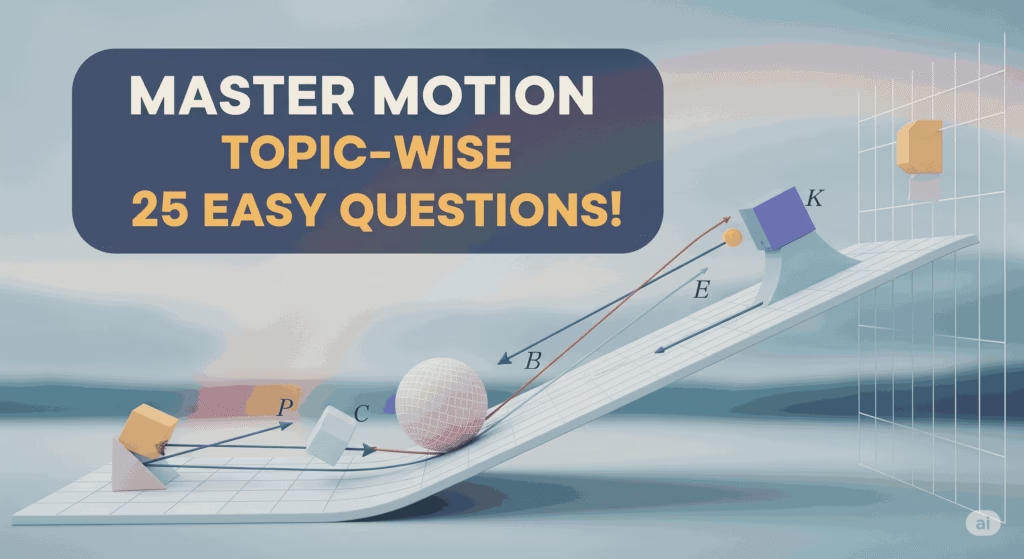“Plant Tissue Class 9 Tissue Chapter 6 Short Notes” is the second part of the two part series of short notes on Tissue chapter 6 class 9.
Every important keyword from the chapter Tissue has been carefully included — nothing’s been left out!
The short notes is divided into two parts for each main topic:
- The short notes with keywords and,
- The second part in tabular format with all the keywords and their meanings or definition.
Related | Animal Tissue – class 9 chapter 6 Tissue short notes
What is Tissue?
- Group of cells
- Similar in structure and/or
- Work together for a particular function
Unicellular vs Multicellular Organisms
- Unicellular:
- Single cell performs all basic functions
- Example: Amoeba → movement, food intake, gaseous exchange, excretion
- Multicellular:
- Millions of cells
- Most cells specialised for specific functions
- Division of labour present
Specialisation in Multicellular Organisms
- Human examples:
- Muscle cells → contract & relax → movement
- Nerve cells → carry messages
- Blood → transports oxygen, food, hormones, waste
- Plant examples:
- Vascular tissues → conduct food & water
Efficiency Through Grouping
- Specialised cells grouped together
- Cluster at definite place in body
- Cluster = tissue
- Arranged for highest functional efficiency
Examples of Tissues
- Blood
- Phloem
- Muscle
Important Keywords
| Keyword | Main Point |
|---|---|
| Tissue | Group of similar cells working together for a particular function |
| Unicellular | Single cell does all functions (e.g., Amoeba) |
| Multicellular | Millions of cells; show division of labour |
| Specialisation | Cells perform specific functions efficiently |
| Division of labour | Different cell groups handle different tasks in multicellular organisms |
| Muscle cells | Contract and relax to cause movement |
| Nerve cells | Carry messages |
| Blood | Transports oxygen, food, hormones, waste |
| Vascular tissues | Conduct food and water in plants |
| Phloem | Example of plant tissue |
| Efficiency | Tissues arranged for highest possible functional efficiency |
| Cluster of cells | Grouped at definite body location to perform a function |
Key Differences : Plants vs Animals
Lifestyle & Movement
- Plants:
- Stationary (fixed in place)
- Do not move
- Animals:
- Move for food, mates, shelter
- Active locomotion
Supportive Tissues
- Plants:
- Need upright support → large amount of supportive tissue
- Supportive tissue = mostly dead cells
- Animals:
- Most tissues = living cells
- Higher energy consumption
Growth Pattern
- Plants:
- Growth limited to certain regions
- Some tissues divide throughout life
- Dividing tissues = localised
- Plant tissues classified as:
- Meristematic (growing)
- Permanent (non-dividing)
- Animals:
- Uniform cell growth
- No clear demarcation between dividing & non-dividing regions
Structural Organisation
- Animals:
- Organs & organ systems = more specialised & localised
- Plants:
- Less specialised organisation, even in complex forms
Reason for Differences
- Due to different modes of life:
- Plants: sedentary existence
- Animals: active locomotion
- Also linked to different feeding methods and adaptations
Important Keywords
| Keyword | Main Point |
|---|---|
| Stationary | Plants are fixed; do not move |
| Supportive tissue | Plants have large amount; mostly dead cells |
| Living tissues | Animals mostly have living cells |
| Energy consumption | Animals consume more energy than plants |
| Growth pattern | Plants: limited to certain regions; Animals: uniform |
| Meristematic tissue | Plant tissue that divides throughout life |
| Permanent tissue | Plant tissue that does not divide |
| Localised growth | Plant cell division occurs only in specific regions |
| No demarcation | Animals lack clear dividing/non-dividing tissue zones |
| Structural organisation | More specialised & localised in animals than in plants |
| Sedentary existence | Plants adapted to fixed lifestyle |
| Active locomotion | Animals move actively; affects tissue and organ design |
| Feeding methods | Different between plants and animals; influences tissue types |
Where Growth Occurs
- Only in specific regions
- Due to presence of meristematic tissue (dividing tissue)
Meristematic Tissue
Meristematic tissue is made up of immature cells that have the ability to divide and differentiate into permanent tissues.
Types of Meristematic Tissue
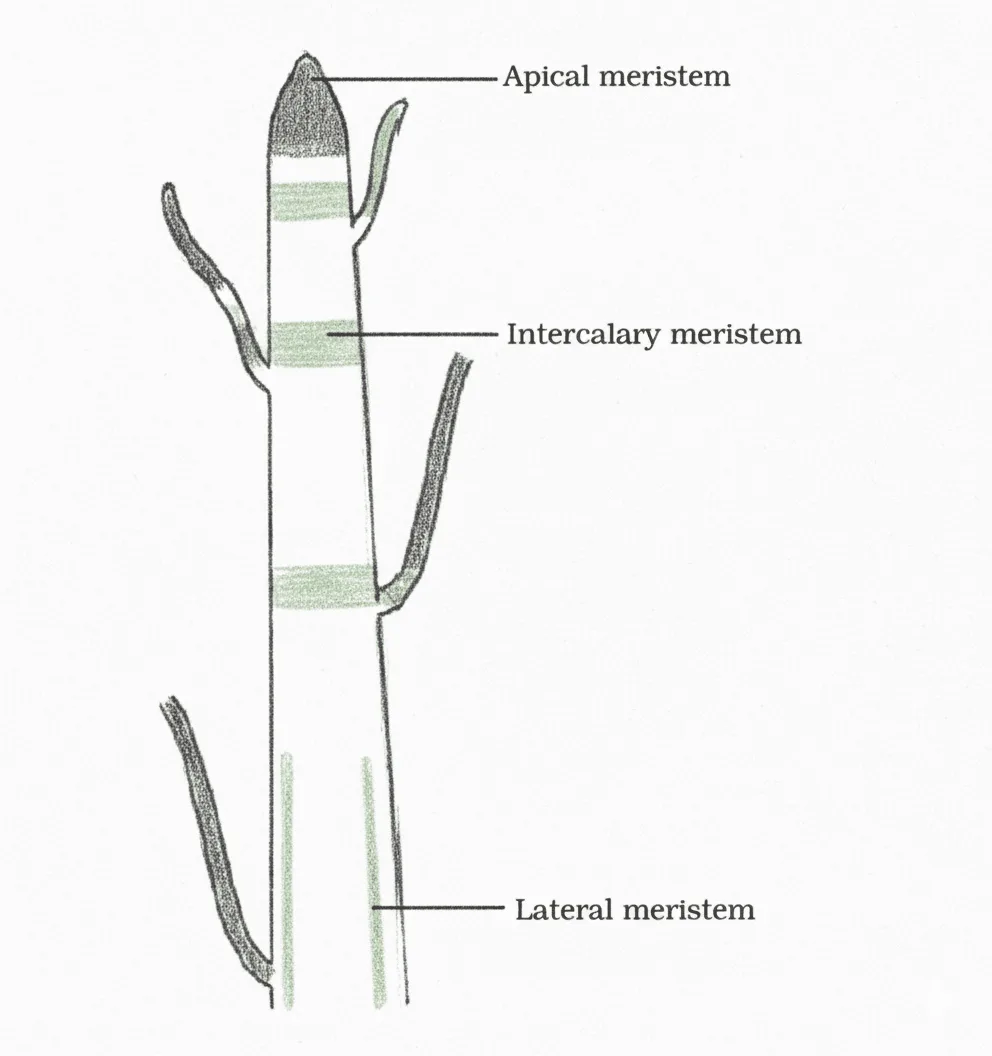
- Apical meristem:
- At tips of stems & roots
- Increases length
- Intercalary meristem:
- Located near the node
- Found in some plants
- Lateral meristem:
- Includes cambium
- Increases girth of stem/root
Cell Features Of
Meristematic Tissue
- Very active cells
- Dense cytoplasm
- Thin cellulose walls
- Prominent nuclei
- Lack vacuoles
Cell Development
- New cells → initially like meristem cells
- As they grow & mature → differentiate into other tissue types
Important Keywords
| Keyword | Main Point |
|---|---|
| Meristematic tissue | Dividing tissue; located only in specific growth regions |
| Apical meristem | At tips of stems/roots; increases length |
| Lateral meristem | Includes cambium; increases girth |
| Intercalary meristem | Near node; present in some plants |
| Dense cytoplasm | Feature of meristematic cells |
| Thin cellulose walls | Present in meristematic cells |
| Prominent nuclei | Meristematic cells have large, visible nuclei |
| Lack vacuoles | Meristematic cells do not have vacuoles |
| Differentiation | New cells mature and become part of other tissues |
| Specific regions | Plant growth limited to areas with meristematic tissue |
Permanent Tissue
When cells take up a specific
role and lose the ability to divide,
they form a permanent tissue.
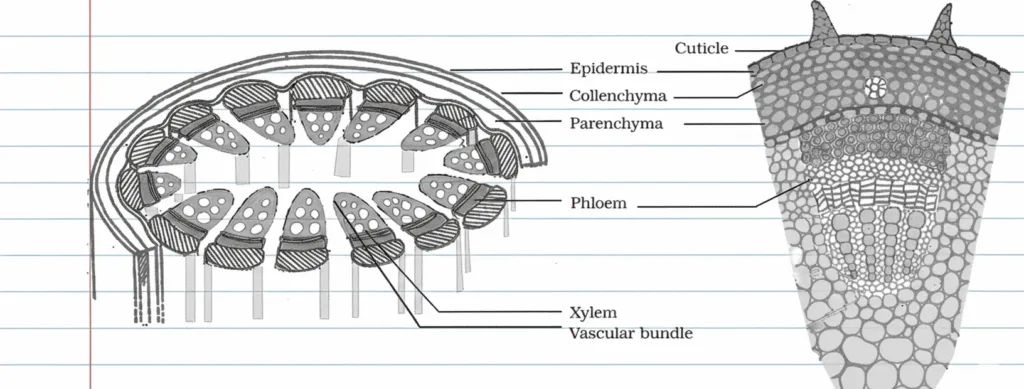
Formation of Permanent Tissue
- Cells from meristematic tissue → take up specific role
- Lose ability to divide → become permanent tissue
- Process = differentiation
- Leads to various types of permanent tissues
Simple Permanent Tissues
Parenchyma
- Most common simple permanent tissue
- Living cells, thin walls, unspecialised
- Loosely arranged → large intercellular spaces
- Stores food
- With chlorophyll → chlorenchyma (photosynthesis)
- In aquatic plants → aerenchyma (air cavities for floating)
Collenchyma
- Provides flexibility & mechanical support
- Allows bending (e.g., tendrils, climber stems)
- Found in leaf stalks below epidermis
- Living, elongated, irregularly thickened at corners
- Very little intercellular space
Sclerenchyma
- Makes plant hard & stiff
- Dead cells, long & narrow
- Walls thickened with lignin → often no internal space
- Found in:
- Stems
- Around vascular bundles
- Leaf veins
- Hard coverings of seeds/nuts (e.g., coconut husk)
- Provides strength

Protective Tissues
Epidermis
- Outermost layer of plant
- Usually single layer of cells
- Protects all plant parts
- No intercellular spaces → continuous layer
- Flat cells; outer & side walls thicker
- Aerial parts: secrete waxy, water-resistant layer → prevents:
- Water loss
- Mechanical injury
- Fungal invasion
- In dry habitats: thicker epidermis
- Desert plants: thick cutin coating (waterproof)
Specialised Epidermal Features
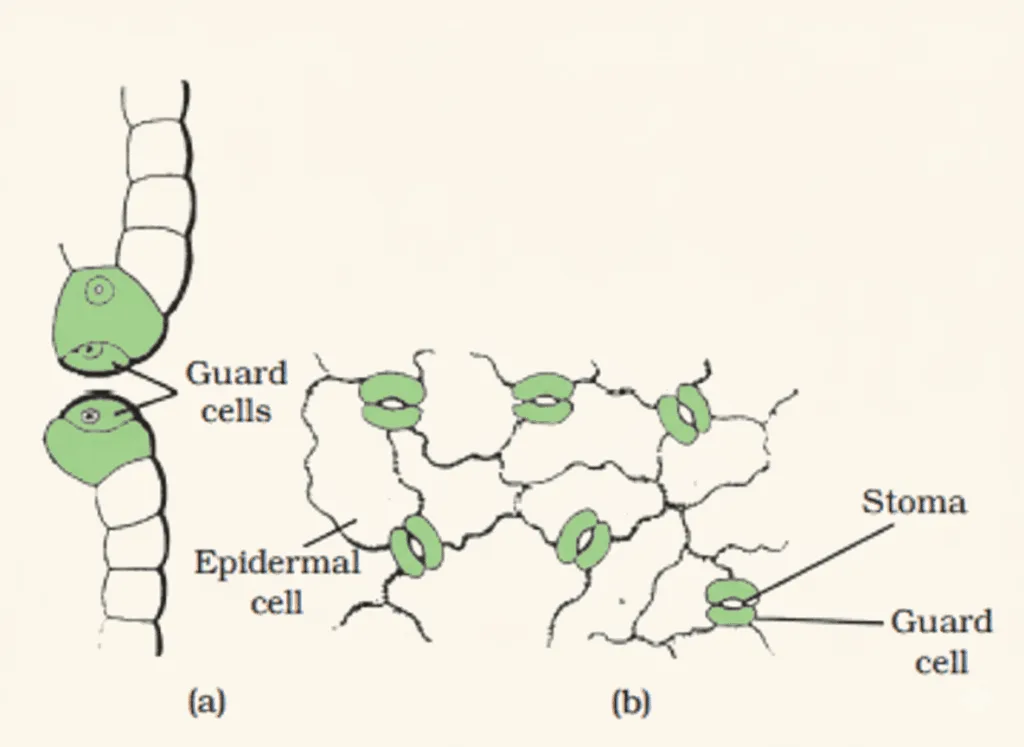
Stomata
- Pores in leaf epidermis
- Surrounded by two kidney-shaped guard cells
- Function: gas exchange & transpiration
Root hairs
- Long, hair-like outgrowths on root epidermal cells
- Increase absorptive surface area for water
Cork (in Older Plants)
- Forms as plant ages
- Produced by secondary meristem in cortex
- Dead cells, compactly arranged, no intercellular spaces
- Walls contain suberin → impermeable to water & gases
- Replaces epidermis in older stems/branches
Important Keywords
| Keyword | Main Point |
|---|---|
| Permanent tissue | Formed when meristematic cells differentiate and lose division ability |
| Differentiation | Process of acquiring permanent shape, size, and function |
| Parenchyma | Living, thin-walled, stores food; loose with intercellular spaces |
| Chlorenchyma | Parenchyma with chlorophyll → performs photosynthesis |
| Aerenchyma | Parenchyma with air cavities → helps aquatic plants float |
| Collenchyma | Living, flexible, thickened at corners; supports bending |
| Sclerenchyma | Dead, lignin-thickened walls; provides hardness & strength |
| Epidermis | Outer protective single-cell layer; continuous, no intercellular spaces |
| Cutin | Waxy, waterproof coating on desert plant epidermis |
| Stomata | Pores for gas exchange and transpiration |
| Guard cells | Kidney-shaped cells surrounding stomata |
| Root hairs | Increase water absorption surface area |
| Cork | Dead, suberin-rich tissue in older plants; replaces epidermis |
| Suberin | Makes cork impermeable to water and gases |
Complex Permanent Tissue
What is Complex Tissue?
- Made of more than one type of cell
- All cells coordinate to perform a common function
- Xylem and phloem = examples
- Together form vascular bundle
- Vascular tissue = key feature of complex plants → enables terrestrial survival
Xylem
- Function:
- transports water & minerals (vertically)
- Components:
- Tracheids: tubular, thick-walled, dead at maturity
- Vessels: tubular, thick-walled, dead at maturity
- Xylem parenchyma: stores food (living)
- Xylem fibres: provide mechanical support (dead)
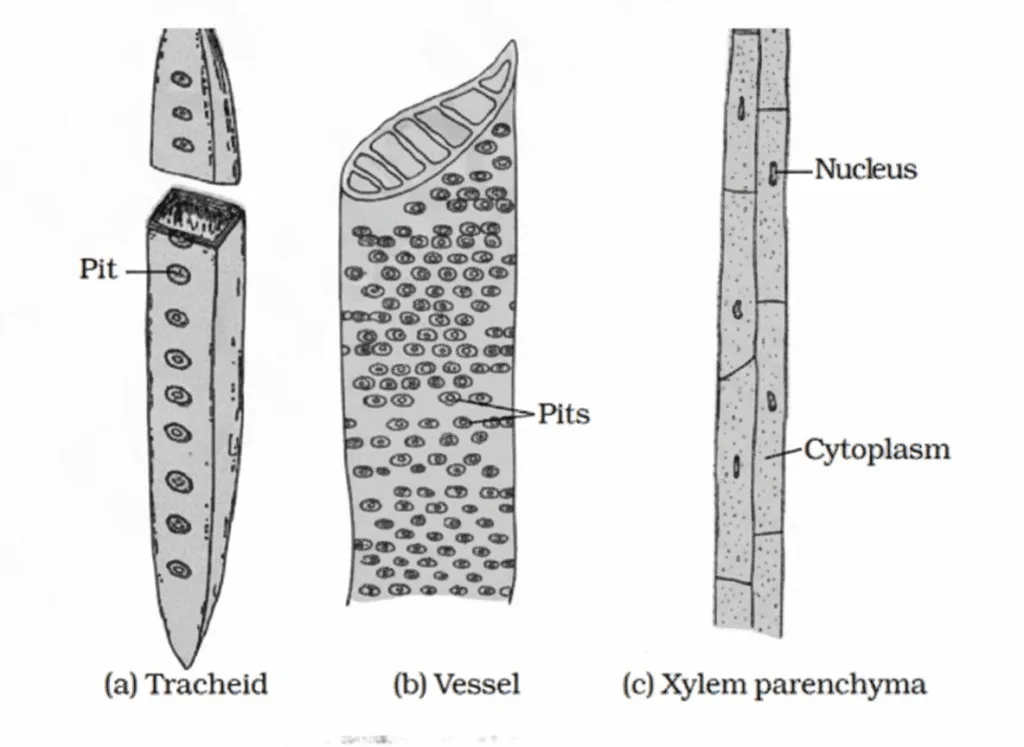
Phloem
- Function:
- transports food from leaves to other plant parts
- Components:
- Sieve cells
- Sieve tubes: tubular with perforated walls
- Companion cells
- Phloem parenchyma
- Phloem fibres
- All phloem cells are living except phloem fibres
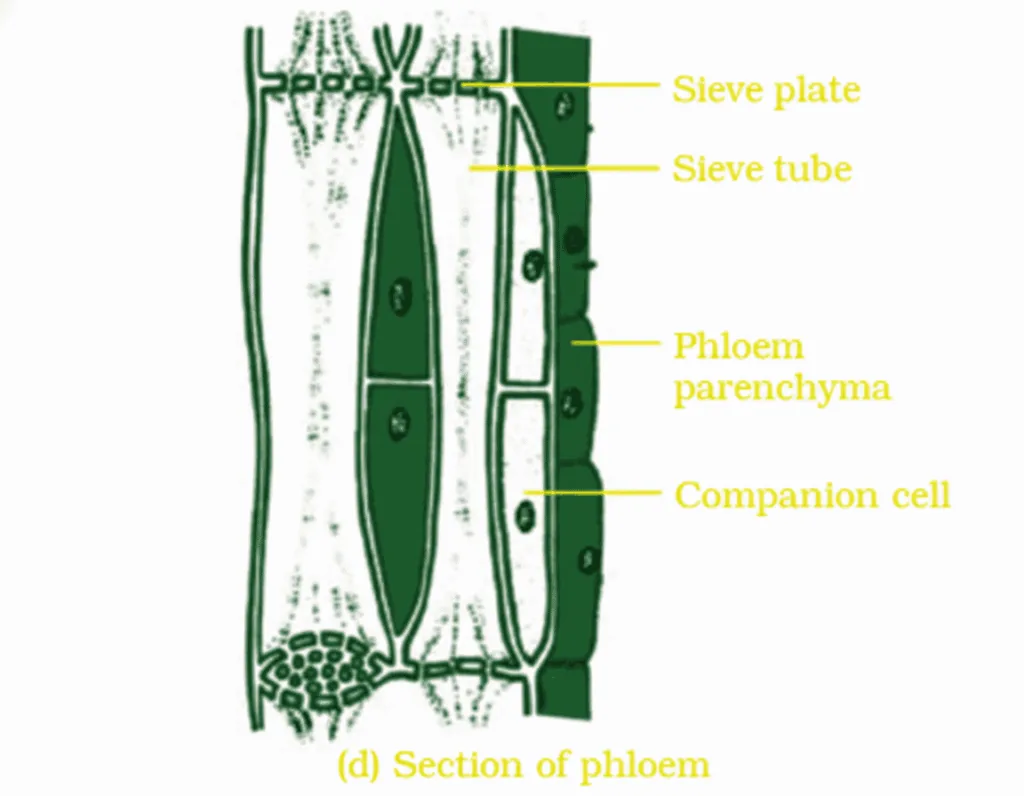
Important Keywords
| Keyword | Main Point |
|---|---|
| Complex tissue | Made of >1 cell type; cells work together for common function |
| Xylem | Conducts water & minerals; part of vascular bundle |
| Phloem | Conducts food; part of vascular bundle |
| Vascular bundle | Contains xylem & phloem; key for terrestrial plant survival |
| Tracheids | Tubular, thick-walled, dead; transport water/minerals |
| Vessels | Tubular, thick-walled, dead; efficient water conduction |
| Xylem parenchyma | Living; stores food |
| Xylem fibres | Dead; provide support |
| Sieve tubes | Tubular with perforated walls; transport food |
| Companion cells | Living; associated with sieve tubes |
| Phloem parenchyma | Living; part of phloem |
| Phloem fibres | Only dead cells in phloem; provide support |
| Living phloem cells | All except phloem fibres are living |
FAQs : Plant Tissue Class 9 Tissue Chapter 6 Short Notes
Q1. How should I use the short notes?
Ans- First read your NCERT texbook 10 to 15 times and then read the above short notes agian and agian.
And just 3 or 4 days before the exam try to memorize the short notes
Q2. Is the short notes provided above is sufficient?
Ans- Absolutely Yes!
Q3. Should I also prepare the diagrams?
Ans – Yes! many questions based on diagrams have been asked in exams in the form of MCQs
If you have any other question, please comment or contact us.

